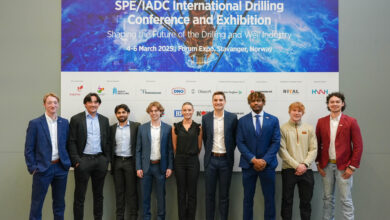Technical Session 16 – Directional Drilling
Editor’s note: These abstracts have been edited for space and clarity. This program is current as of 15 January 2013. Additions, withdrawals and other changes to the conference program after this date may not be reflected. Click here for the most updated program.
TECHNICAL SESSION 16: DIRECTIONAL DRILLING
SPE/IADC 163526
Drilling Unconventional Shale Wells Remotely, C. Gongora, O. Awan, J.F. Mota, Shell; E. van Oort, University of Texas Austin
After a successful pilot application in the Haynesville Shale, Shell Upstream Americas is currently transferring all of its directional drilling, MWD/LWD and geosteering operations in the Americas to remote drilling centers. In this paper, we provide all the learnings and best practices associated with the implementation of the remote drilling centers for unconventional shale drilling operations.
This includes a review of the technologies involved, the new workflows that were implemented and changes that were managed, how the “people issues” were addressed, and what results – including a three-fold reduction in staff at the rigsite and 90% improvement in the speed of decision making – were obtained. In addition, we will comment on the potential to broaden the approach to other drilling and completion operations (e.g. frac jobs, offshore drilling, etc).
SPE/IADC 163534
Innovative Drilling System with a Built-In Kick-Off Ramp Allows Dependable Curve Building in Granite Wash Formation, P.C. Desai, S.N. Swadi, A.J. Klassen, Schlumberger; G.A. Bruton, J. Talkington, Chesapeake Operating
Granite Wash formation in Beckham County, Oklahoma and surrounding areas presents a number of challenges in drilling build section from a vertical openhole to form a horizontal lateral in the productive zone. The formation is hard and abrasive and it is difficult to anticipate rock properties downhole from one well to the next. This erratic nature of the formation results in unpredictable performance by the steerable drilling assembly and drill bits particularly in the build section below 12,000 ft.
To remedy the issue, an innovative drilling system was developed, which provides a dependable kick-off ramp and a firm beginning in initiating the build section without having to rely on the drilling BHA’s fulcrum point.
The authors will describe in detail the system components and the running procedure. They will also discuss system performance in the field along with realized benefits to the customer, lesson learned, planned improvements and the way forward activities.
SPE/IADC 163430
Automated Decision Support to Enhance While-Drilling Decision Making: Where Does it Fit within Drilling Automation?, A.G. Sadlier, I.P. Says, Baker Hughes; J.E. Webster, Verdande Technology
A case history is presented on the use of case-based reasoning to enhance automated advice by identifying hazardous situations in advance that enabled successful corrective action implementation.
SPE/IADC 163463
Extended Reach Drilling – New Solution with a Unique Potential, O.M. Vestavik, Reelwell
The Reelwell Drilling Method (RDM) is a multi-purpose drilling method with a unique flow arrangement. RDM enables improved hole cleaning and improved downhole pressure control and has features for extended reach drilling (ERD). The development of RDM started in 2004 and was qualified for commercial use following the successful pilot well for Shell and Statoil.
In January 2011, Reelwell started a large joint industry project called “ERD beyond 20 km,” supported by Shell, TOTAL, Petrobras and RWE Dea and the Research Council of Norway. The project goal is to verify the extreme ERD capability, beyond conventional reach.
The paper will cover the current status of the RDM from this development and present simulation and test results to verify the ERD potential. Further, an outlook for the extreme ERD capability of the RDM technology will be presented.
SPE/IADC 163405
Novel Technique to Drill Horizontal Laterals Revitalizes Aging Field, S.D. Cinelli, A.H. Ahmed Kamel, University of Alaska Fairbanks
This paper outlines the recompletion of a portion of a 40-year old field using radial jet drilling. It is a carbonate reservoir with low permeability. The combination of low permeability, low productivity of traditional vertical completions in thin net pay and lack of low cost techniques to increase production caused production to dwindle.
After acquiring the lease in late 2010, the operator implemented a program of radial jet drilling and acid/nitrogen fracturing to increase field production. The operator was able to realize nearly a five-fold production increase after the work was complete.
SPE/IADC 163485
Offshore Angola Deepwater ERD: Drilling Optimization Case History, H. Jerez, R. Dias, J.D. Tilley, Halliburton
Extended reach step-out wells provide challenging opportunities for the drilling team. A deepwater extended reach well for a major operator in Angola required a tangent section in a soft formation maintaining a 70° drift angle for 11,000 ft in a single hole interval. The production hole section required steering the well into the best section of the pay-zone. To accomplish the drilling objectives, an exhaustive, detailed plan with multiple scenarios was required before the well was drilled.
E-POSTERS:
SPE/IADC 163428
Torsional Resonance – An Understanding Based on Field and Laboratory Tests with Latest Generation Point-the-Bit Rotary Steerable System, L.A. Lines, D.R. Stroud, V. Coveney, Weatherford
The paper describes a high frequency, high amplitude type of torsional vibration not previously observed with point-the-bit rotary steerable systems. This particular type of torsional vibration is of such high frequency that conventional logging rates are insufficient to detect it. The phenomena could be much more widespread than currently recognized.
SPE/IADC 163529
Pivot Stabilizer Innovations for Point the Bit Rotary Steerable Systems Result in Improved Drilling Performance for Specific Applications, C. Jeffery, M. Bailey, R. Rivera, M. Coss, National Oilwell Varco
To achieve optimal directional response and maintain superior stability in specific applications, pivot stabilizer design, selection and evaluation are crucial when used as a near-bit pivot on point the bit rotary steerable systems. This paper describes the progression of stabilizer design through simulations, facility testing, field testing and in-service performance tracking. Extensive testing and performance evaluation has allowed development of predictable directional response, bit/drill string stability, and other drilling performance metrics of specific stabilizer designs to be rationally chronicled for continual innovation in pivot stabilizer design.
SPE/IADC 163572
A New Measurement-While-Drilling System Designed Specifically for Drilling Unconventional Wells, S.J. Krase, Navigate Energy Service
The recent drilling explosion targeting unconventional reservoirs has created extraordinary opportunities for growth in the oil industry and has also presented many challenges for the MWD industry.
A new generation of MWD systems has been created specifically for the unconventional drilling environment. Starting with a blank sheet of paper enabled the development of a fit-for-purpose MWD system that meets the technical and financial requirements for drilling these unconventional reservoirs.
SPE/IADC 163538
The Combined Application of Azimuthal Deep Resistivity and Multilateral Technologies Maximizes Extra-Heavy Oil Recovery and Improves Production Rates in Junin Block of the Orinoco Oil Belt, O. Mendez, Halliburton
PDVSA Petrocedeño has encountered challenges in achieving higher production rates and maximizing extra-heavy oil recovery from complex reservoirs in Junin block of the Orinoco Oil Belt of Venezuela. Horizontal wells in this area show poor production results.
The YC36 well plan included drilling two laterals with the geosteering technique, which would improve the production rate to an estimated 343 BPD. This paper describes the combined application of multilateral and geosteering technologies in the YC36 well, as well as details about the results of the application.
SPE/IADC 163562
New Technology Enhances Rotary Steerable System Performance and Provides Superior Borehole Quality and Reduces Vibration in Rotary Steerable Applications, D. Herrington, National Oilwell Varco; S.P. Barton, NOV Downhole Tools and Pumping
Rotary steerable systems (RSS) have become a standard technology in today’s drilling industry. With the advent of the RSS, have come new challenges associated with well bore quality, steerability and vibration mitigation. The need for technology that supports and compliments RSS operations is the next logical step in providing optimized RSS drilling services.
This paper provides supporting documentation that a technology proven to improve lateral stability while mitigating damaging downhole vibrations is assisting a major operator in maximizing the performance of their RSS operations and allowing operators a new level of performance and cost savings.




